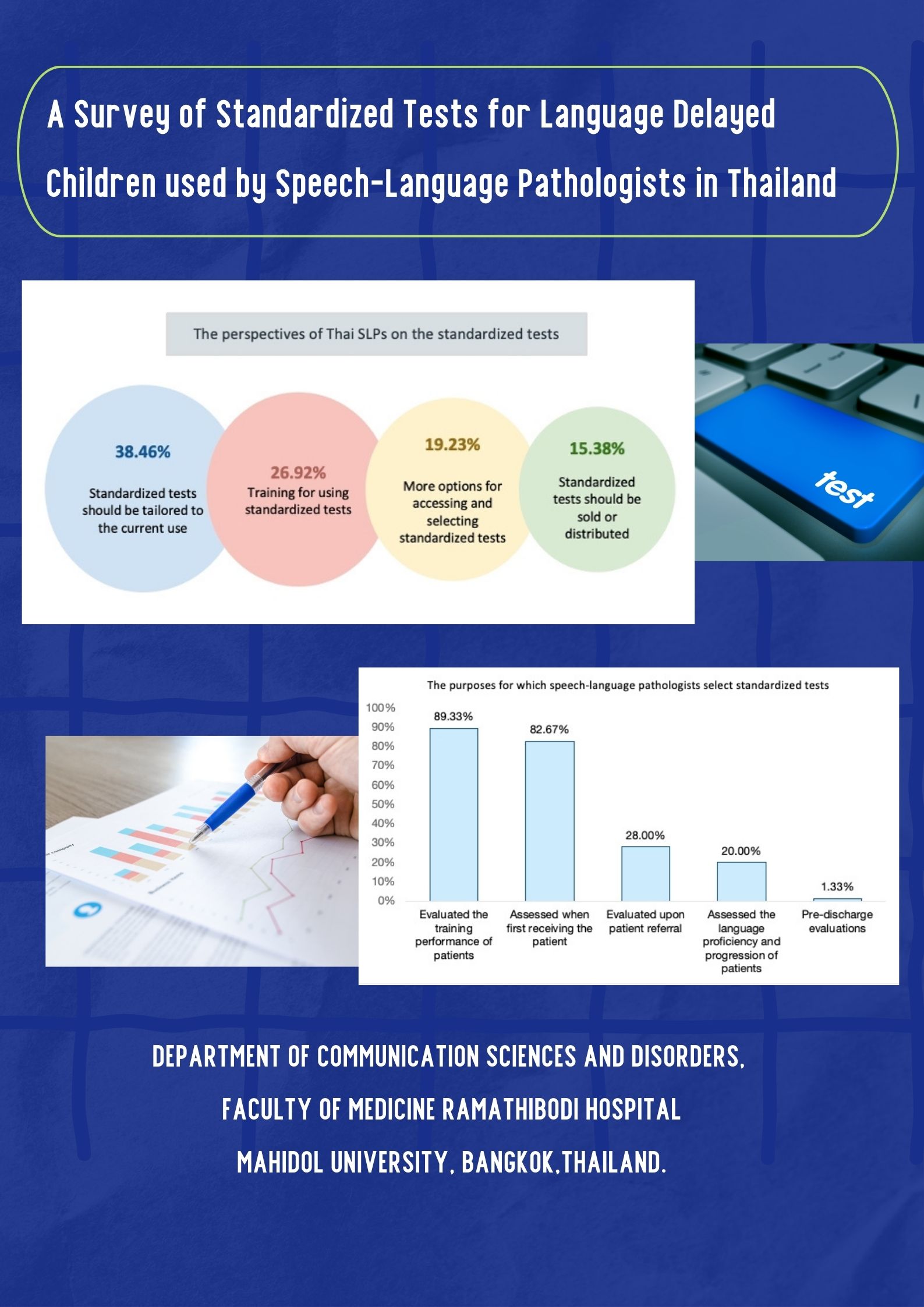A survey of standardized tests for language-delayed children used by speech-language pathologists in Thailand
Main Article Content
Abstract
Objectives: The objective of this study was to investigate how speech-language pathologists in Thailand utilized standardized assessments to evaluate children with language development disorders and to discover the perspectives of Thai speech-language pathologists regarding standardized tests.
Materials and methods: This survey sample included 80 Thai speech-language pathologists who were at least 21 years old and had worked for at least one year. The research instrument consisted of a questionnaire of the speech-language pathologists’ use of the standardized test to evaluate children on their language development problems. The standardized tests utilized in this study were based on the research of graduate students at the Faculty of Medicine Ramathibodi Hospital in the field of communication problems, as recommended by the Audiology and Speech-Language Pathology professional standards in Thailand.
Results: A questionnaire survey found that 92.50% of speech-language pathologists have assessed patients by using standardized tests in combination with informal tests. The most common reason for speech-language pathologists in choosing the standardized test was to summarize the patient’s abilities during training. The other reasons, used in the early stages of receiving patients, were to refer patients, to assess a patient’s language proficiency and progress, and to prepare for the discharge of patients.
Conclusion: The majority of speech-language pathologists suggested that standardized tests should be improved to match the current applications, cover patients, and allow easy interpretation of the test results.
Article Details

This work is licensed under a Creative Commons Attribution-NonCommercial-NoDerivatives 4.0 International License.
Personal views expressed by the contributors in their articles are not necessarily those of the Journal of Associated Medical Sciences, Faculty of Associated Medical Sciences, Chiang Mai University.
References
Department of Health. Annual report of the Department of Health 2020. Nonthaburi: Ministry of Public Health; 2020. (in Thai).
Owens RE. Language disorders: a functional approach to assessment and intervention. 4th Ed. Boston: Allyn & Bacon; 2004.
Shipley KG, McAfee JG. Assessment in speech-language pathology: a resource manual. 3rd Ed. New York: Thomson/Delmar Learning; 2004.
Paul R. Language disorders from infancy through adolescence: assessment & intervention. 3rd ed. St. Louis: Mosby Elsevier; 2007.
Caesar LG, Kohler PD. Tools clinicians use: A survey of language assessment procedures used by schoolbased speech-language pathologists. Commun Disord Q. 2009; 30(4): 226-36.
Khoja MA. A survey of formal and informal assessment procedures used by speech-language pathologists in Saudi Arabia. Speech Lang Hear. 2019; 22(2): 91-9.
Thai Speech-Language and Hearing Association. Code of Ethics, Professional Standards for Audiology and Speech Correction. Khon Kaen: Khon Kaen Printing; 2000.
Harnchumpol W. Auditory comprehension of language in Thai children aged 5 to 6 years 11 months in Bangkok [thesis]. Bangkok: Mahidol University; 1987.
Puntong L. Auditory comprehension of language in Thai children aged 3 years to 4 years 11 months in Bangkok [thesis]. Bangkok: Mahidol University; 1987.
Panyapawakul A. The auditory comprehension of some adjectives and prepositions in Thai Language among children aged 3 years 6 months to 4 years 11 months in the kindergarten schools in Bangkok [thesis]. Bangkok: Mahidol University; 1989.
Ariyasoponwong S. The auditory comprehension ability of some adjectives in the comparative and superlative degree among Thai children aged 3 years to 4 years 11 months in Bangkok [thesis]. Bangkok: Mahidol University; 1989.
Keawnoi D. The study of psycholinguistic abilities of children aged 6 years to 9 years 11 months by using ITPA [thesis]. Bangkok: Mahidol University; 1993.
Ketudat R. The ability of auditory comprehension of numeral classifiers in Thai children aged 3 years to 7 years 11 months in Phrawet Phrakanong and Khlong Toey [thesis]. Bangkok: Mahidol University; 1995.
Wilainam W. The production ability of verbs in Thai children aged 3 years to 4 years 11 months in Bangkok [thesis]. Bangkok: Mahidol University; 1996.
Tumningan B. The ability of auditory comprehension of basic vocabularies in Thai children aged 4 years to 6 years 11 months in Thonburi and Chomthong Districts in Bangkok [thesis]. Bangkok: Mahidol University; 1996.
Kasemkosin N. The study of verbal production of sentences in normal children aged 4 years to 6 years 11 months by picture arrangement [thesis]. Bangkok: Mahidol University; 1996.
Krisanachantr O. The study of production ability of adjective and preposition antonym pairs in Thai children aged 4 years to 6 years 11 months in Muang district, Chonburi province [thesis]. Bangkok: Mahidol University; 1998.
Intasiri T. The construction of the Thai syntactic development test for children aged 3-7: 11 years old in Bangkok metropolitan [thesis]. Bangkok: Mahidol University; 2000.
Onnark P. The construction of the Thai semantic development test for children aged 3-7: 11 years old in Bangkok metropolitan [thesis]. Bangkok: Mahidol University; 2000.
Lattanan P. Receptive and expressive language of Thai children from birth to 36 months by using a Thai adaptation of the receptive-expressive emergent language test (Reel-3) [thesis]. Bangkok: Mahidol University; 2010.
Ballantyne AO, Spilkin AM, Trauner DA. The revision decision: Is change always good? A comparison of CELF-R and CELF-3 test scores in children with language impairment, focal brain damage, and typical development. Lang Speech Hear Serv Sch. 2007; 38(3): 182-9.


